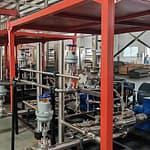A diving cylinder, scuba tank or diving tank is a gas cylinder used to store and transport the high pressure breathing gas required by a scuba set. It may also be used for surface-supplied diving or as decompression gas or an emergency gas supply for surface supplied diving or scuba. Cylinders provide gas to the diver through the demand valve of a diving regulator or the breathing loop of a diving rebreather.
Diving cylinders are usually manufactured from aluminium or steel alloys, and are normally fitted with one of two common types of cylinder valve for filling and connection to the regulator. Other accessories such as manifolds, cylinder bands, protective nets and boots and carrying handles may be provided. Various configurations of harness may be used to carry the cylinder or cylinders while diving, depending on the application. Cylinders used for scuba typically have an internal volume (known as water capacity) of between 3 and 18 litres (0.11 and 0.64 cu ft) and a maximum working pressure rating from 184 to 300 bars (2,670 to 4,350 psi). Cylinders are also available in smaller sizes, such as 0.5, 1.5 and 2 litres, however these are often used for purposes such as inflation of surface marker buoys, drysuits and buoyancy compensators rather than breathing. Scuba divers may dive with a single cylinder, a pair of similar cylinders, or a main cylinder and a smaller “pony” cylinder, carried on the diver’s back or clipped onto the harness at the sides. Paired cylinders may be manifolded together or independent. In some cases, more than two cylinders are needed.










No comment